Cast iron is the chinese grandma of cookware: the ultimate in practicality, durability and value – and it only gets better with age. It is also nonstick the old school way. If anyone out there is still using Teflon-coated pans, I urge you to wake up and smell the plastic. A high quality cast iron skillet that will last you a lifetime costs less than $20 and doesn’t kill birds like Teflon.
Like the canary in the coal mine, dying pet birds have been warning us about the dangers of nonstick pans for years. I got rid of my nonstick pans eight years ago, figuring that what kills birds can’t be good for kids or the rest of us. Here’s an excerpt from the Environmental Working Group:
Bird enthusiasts and veterinarians have known for decades that Teflon-coated and other non-stick cookware, if heated to high temperatures, is acutely toxic to birds. The peer-reviewed literature contains numerous reports of bird deaths linked to the use of Teflon and other non-stick pans and appliances in the home, beginning about 30 years ago. The birds die abruptly, usually shortly after new non-stick pans are heated for the first time. The ubiquity of the deaths has spurred mention of the problem on at least 100 websites devoted to the care of pet birds.
You can read the rest of the EWG analysis here.
The beautiful cast iron pans pictured here are from family-owned American manufacturer Lodge Cast Iron, which has been making quality cast iron cookware since 1896 and claims that some of their original cast iron skillets, dutch ovens and griddles are still in use. This is cookware to last generations.
Cast iron pans do require a tiny bit of know-how for cleaning and maintaining the seasoned surface. In 2002, Lodge introduced a line of pre-seasoned cookware called Lodge Logic (happily just as I was looking for nonstick alternatives), which saves us all from having to do the initial seasoning. Unlike traditional cast iron, which needs to be coated with oil and baked at a low temperature for several hours, these are ready to use. They arrive beautifully matte black, instead of the metallic gray of unseasoned cast iron, and the line was so popular immediately that they don’t seem to sell the unseasoned cast iron anymore.
Here’s what you need to know about cast iron maintenance:
1. Clean with a stiff brush and hot water – NO soap (soap will strip the seasoning). For hard to clean messes, you can also put water in pan and boil on stovetop to loosen, but I’ve never actually had to do this.
2. Don’t put in dishwasher (in case that wasn’t obvious from #1).
3. Dry pan after cleaning to prevent rust – I usually leave it to dry on my stovetop, as the grates leave plenty of ventilation for quick drying. You won’t want to leave wet cast iron on a flat surface, because it won’t have air to dry beneath.
4. When cooking, add a bit of oil and heat pan before adding food – food will stick if pan is cold. Cast iron not as slippery a surface as Teflon, but it does the job well if used properly.
5. Wipe pan in and out with a bit of oil when the surface gets dull. Lodge recommends doing this after each use, but you can get by on less.
I want to show you how easy this is. A bit of oil in my neglected skillet. Wipe with a paper towel.
Turn over – ooh, rusty.
The oil works like magic.
Here’s my half-oiled skillet bottom.
Now complete.
I feel so renewed.
Two things to know about using cast iron:
1. It is heavy.
2. The handle gets hot.
My skillets are 8″, 10 1/4″ and 12″, and only the huge 12″ skillet gives me problems with weight. I use the 8″ for omelets, a single fried egg or a grilled sandwich. The 10 1/4″ is my favorite all-purpose skillet. I think it is perfect for a family of four, a great size for sauteeing or pan frying meat and vegetables. Plus I find it’s still manageable with one hand. With my large family I use my 12″ skillet frequently, but I always wish it weren’t quite so heavy. I have to scoop out food instead of pouring it out from the skillet, which always strikes me as inefficient (though better than accidentally dumping out my food on the counter because I can’t hold the pan steady).
It’s also nice to have a good oven mitt when cooking with cast iron, as the handles get hot. It’s super cheesy looking, but I love the functionality of this Ove Glove. It’s extremely heat-resistant and also has a grippy surface so the heavy pan doesn’t slip or turn in transit.
Here are links to the Lodge Logic skillets on Amazon.com, where with a purchase of over $25 they will ship to you free and save you from lugging the cast iron home from the store. Currently the 8″ sells for around $10, the 10 1/4″ for $15, and the 12″ for under $20. If you want to check out the pans (and their weight) in person, I have seen certain models of Lodge Logic cookware at Target and Walmart for similar prices. Williams-Sonoma also carries Lodge Logic, but of course for a higher price.
Lodge Logic 8-inch pre-seasoned cast iron skillet at Amazon.com
Lodge Logic 10-1/4-inch pre-seasoned cast iron skillet at Amazon.com
Lodge Logic 12-inch pre-seasoned cast iron skillet at Amazon.com
By the way, if anyone has old or traditional cast iron that needs to be seasoned, here are directions for seasoning cast iron from wikihow.com.


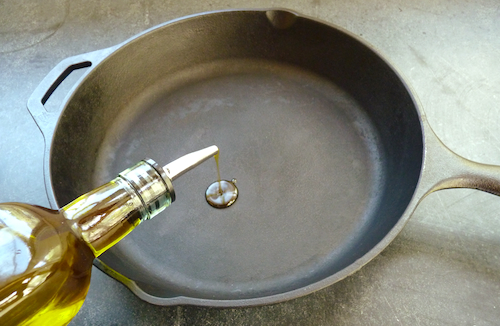
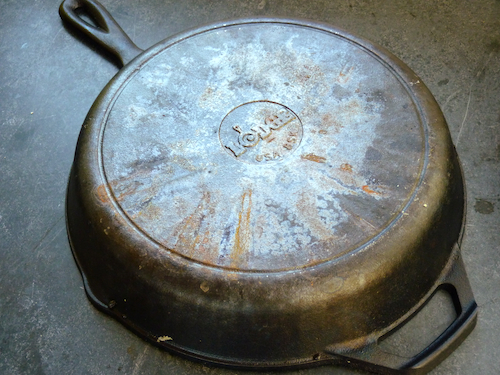
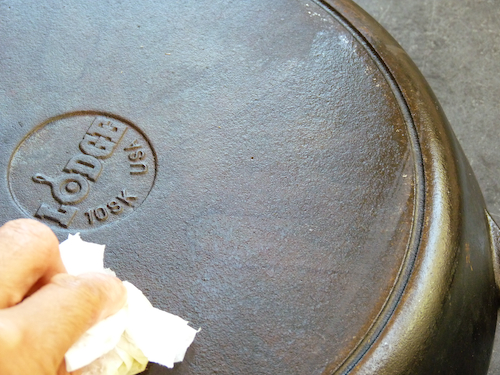
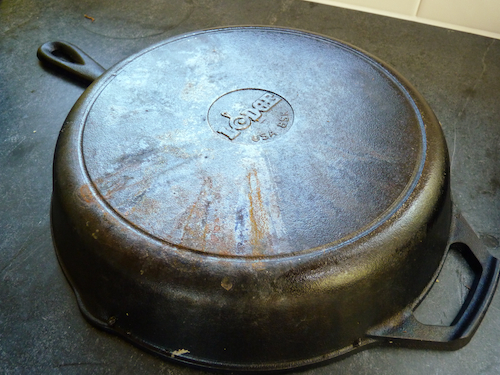
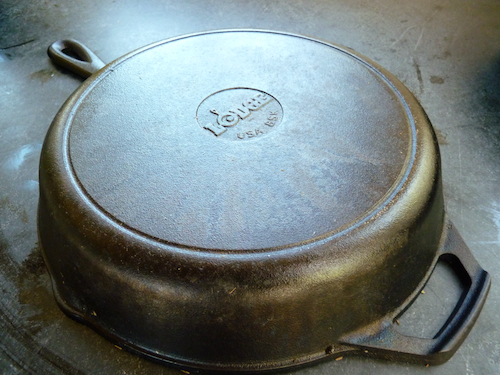
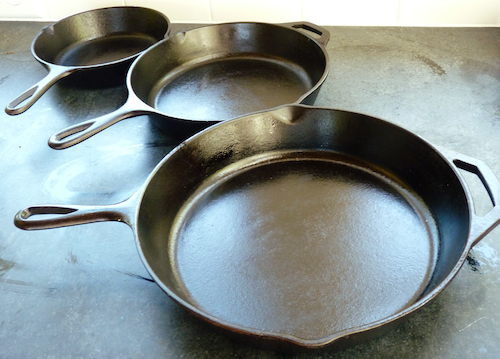

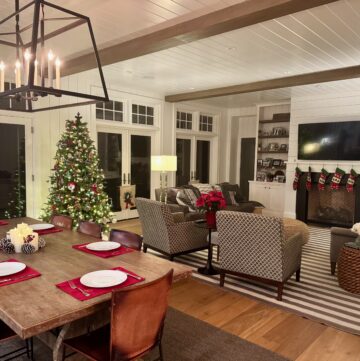
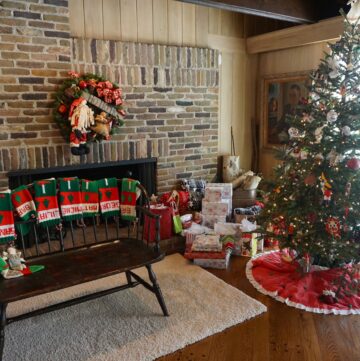
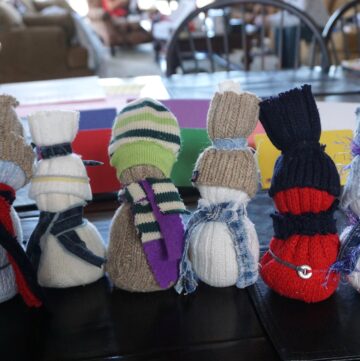
I bought a lovebird a few years back and he died abruptly just a couple days after I got him. Now I think I know why!
what do you use for pancakes? making 2-3 at a time in a 10″ round always bugs me; you either have to keep the first few batches warm in the oven causing them to dry and un-fluff a bit, or eat in turns fresh off the pan. since there’s only two of us, makes me feel a bit like the help when i eat after the boy is done. 🙂 on the flip side, since there is only two of us, getting a 2-burner griddle seems excessive… ho hum, these are the thoughts that keep me up late, procrastinating from working on real things. 🙂
true, true – it is hard for everyone to eat at the same time with pancakes, and i also end up eating after i’ve cooked all the batter. i have a warming shelf above the cooktop in my new kitchen, but i never want to make everyone else wait until they’re all cooked, so everyone else tends to eat first. i do own a lodge cast iron griddle, but it always seems like too much work to haul it out unless i happen to have a large crowd. and if i’m adding toppings it’s hard to pour that many pancake batter rounds on the griddle and then get to all the toppings before the pancakes get too cooked on one side. so i use the 12″ skillet and cook four at a time – for the two of you, you could cook two batches and then sit and eat. but then you’d have to heat the pan again to cook a second batch if you wanted more.
I have been wanting cast iron skillets for a while and I finally ordered them online last night as my birthday presents this year :). Thanks for sharing, cg!
People really do use antique cast iron – that stuff is forever! I have an old Griswold griddle from the 1920’s that gets daily use, and a few other old pieces manufactured in the 40’s and 50’s. This site tells you everything you need to know about restoring the old stuff: http://www.castironcollector.com/
Plain naked stainless for boiling things up quick, and cast iron and/or enameled cast iron for everything else – that’s all you need.
hi stella – thanks for sharing back!